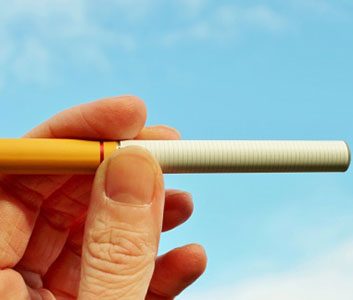The bottom line on e-cigarettes: Are they safe?
No smoke, no fire? What is the truth about e-cigarettes?

Source: Best Health magazine, September 2014
E-cigarettes are hyped as a new tool for butting out. They are smokeless, have no tobacco, and feature a battery-operated cartridge that warms a liquid that may contain nicotine, water, flavouring and propylene glycol (an alcohol that is heated to create the vapour inhaled). Ingredients in the cartridges vary, and not all devices contain nicotine.
Says Dr. Andrew Pipe of the University of Ottawa Heart Institute, some people assume e-cigarettes will help them quit smoking, but ‘early studies haven’t shown significant improvements toward quitting rates.’ More research is also needed to rule out worries around long-term inhalation of the device’s ingredients, including propylene glycol and unregulated amounts of nicotine.
E-cigarettes with nicotine or that make health claims are illegal here, but some Canadians purchase them online from the U.S., the U.K. and even Canada. Gary Scott Holub, a Health Canada spokesperson, says they have not been approved for use, sale or advertisement: ‘A company would have to provide evidence of safety, quality and effectiveness for its product to be authorized.’ Without scientific evidence, Health Canada advises against their use, and the Canadian Cancer Society supports this position. As for e-cigarettes without nicotine, they are legal, but regulations for their use and safety don’t exist. Unfortunately, both types may pose a health risk. ‘Because they’re unregulated, they are manufactured in a variety of settings,’ says Pipe. ‘No one has a clear idea of what’s in the solutions used.’
Could they be a good thing? Maybe. Says Dr. Peter Selby, chief of the addictions division at the Centre for Addiction and Mental Health in Toronto, ‘We’ve known for decades that smokers smoke for the nicotine but die from the smoke. E-cigarettes have the potential to help smokers quit while cutting exposure to the 7,000 chemicals, including 60 that cause cancer, found in cigarettes. There’s incentive to study this technology further and consider a Health Canada-regulated product.’
Vā’ping:
transitive verb to inhale (=breathe into your lungs) the vapour produced by an electronic cigarette(Macmillan Dictionary)
The growing popularity of e-cigarettes is forcing cities, businesses and institutions around the world to take a stand on public use. In New York City, vaping has been banned in bars, clubs and restaurants as of April 2014. In Canada, the University of New Brunswick has become one of the first Canadian educational institutions to ban e-cigarette usage within its buildings. In the private sector, Air Canada and WestJet have policies prohibiting vaping on their planes.
This article was originally titled "No smoke, no fire?" in the September 2014 issue of Best Health. Subscribe today to get the full Best Health experience’and never miss an issue!




